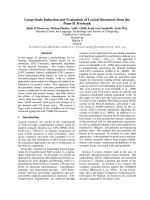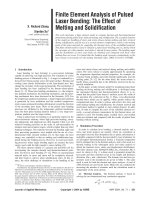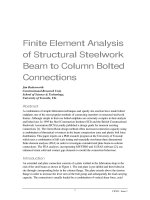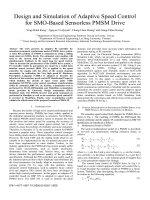Large scale finite element simulation of seismic soil pile foundation structure interaction
Bạn đang xem bản rút gọn của tài liệu. Xem và tải ngay bản đầy đủ của tài liệu tại đây (8.49 MB, 380 trang )
Large-scale Finite Element Simulation of Seismic
Soil-Pile foundation-Structure Interaction
Zhao Ben
National University of Singapore
2013
Large-scale Finite Element Simulation of Seismic
Soil-Pile foundation-Structure Interaction
Zhao Ben
A thesis submitted for the degree of doctor of philosophy
Department of Civil & Environmental Engineering
National University of Singapore
2013
Acknowledgements
Acknowledgements
With great pleasure, I express my sincere and profound gratitude to my
supervisors, Prof Lee Fook Hou and Dr. Goh Siang Huat for their erudite and
invaluable guidance throughout the study. Their gratitude, analytical and
methodical way of working has inspired me and under their guidance I have
learned a lot.
In addition, I would like to thank Dr. Hong Sze Han, Dr. Subhadeep Banerjee, Mr.
Adrian Tan Seck Wei and other fellow colleagues of NUS Geotechnical Division.
I would like to thank NUS for providing all necessary financial and academic
support without which this study would have been a distinct dream.
Finally, grateful acknowledgement is expressed to my family and my fiancé Tian
e
Wei.
i
Declaration
Declaration
I hereby declare that this thesis is my original work and it has been written by me
in its entirety.
I have duly acknowledged all the sources of information which have been used in
the thesis.
This thesis has also not been submitted for any degree in any university previously.
Zhao Ben
03/06/2013
.
i
Abstract
Abstract
The pile group effect is an important factor affecting the performance of pile
foundations and superstructure under earthquake loading. While this topic has
been widely studied over the past fifty years, most of the research was carried out
using single piles or small pile groups. However, the pile foundations for tall
structures and buildings typically consist of a much larger number of piles spaced
quite closely together. Under such conditions, pile-soil-pile interaction effects
during seismic excitation are likely to be significant. To date, such interaction
effects have not been systematically studied for large pile groups.
In this study, the development of a parallel dynamic finite element program for
nonlinear geotechnical analysis is first presented. The program is then used to
perform large-scale finite element analyses involving large piled foundation
systems constructed in predominantly soft clay ground conditions subjected to
earthquake excitation.
The research comprises four major components: (1) the setting up of a network PC
cluster and the development of a parallel finite element code for large-scale
dynamic simulations; (2) the implementation of the key features for seismic finite
element modelling, such as the hysteretic soft soil model with cyclic degradation
and the use of solid elements with stress integration for calculating the pile
bending moments; (3) parametric studies of the large-scale soil-pile-structure
system leading to semi-analytical solutions for the maximum bending moments in
the pile group under earthquake loading; (4) extended studies to examine the
iii
Large-scale Finite Element Simulation of Seismic Soil-Pile foundation-Structure
Interaction
influence of the superstructure, uneven soil stratigraphy and earthquake motion
characteristics on the large-scale pile group effects.
To perform the large-scale simulations, a PC cluster is set up using a high-speed
local network to connect multiple multi-core personal computers. Details of the
network configuration and hardware specifications are presented. The
development of the parallel dynamic finite element program is described, with
emphasis on the choice of iterative solver, method of domain decomposition, and
the use of message passing techniques for distributed memory computing. The
developed code was successfully tested on several large-scale models of varying
sizes, yielding speed-up factors that attest to the computational efficiency and the
high performance potential of this numerical tool.
The finite element program is validated using measured data from centrifuge
shaking table tests involving small 2x2 pile groups. Also, the computed results are
shown to compare favourably with those obtained from ABAQUS 3-D simulations
of the same problem. Following this, larger finite element models of 3x3 pile
groups up to 9x9 pile groups are set up and analysed to study the effect of pile
spacing and pile group size.
The computed results show that pile-to-pile
interaction effects are significant up to a spacing of about nine diameters, while the
effects of pile group size is less obvious although the larger pile group generally
induces a larger response. Finally, analyses are also carried out on a large-scale
soil-pile-structure model with a 9x21 pile foundation that is representative of
typical high-rise building flats and their foundations in Singapore. The computed
Abstract
accelerations, displacements and pile bending moments are discussed.
Furthermore, comparisons of the computed raft accelerations and pile bending
moments are also made with the results obtained using an equivalent linear elastic
soil model and a simplified pseudo-static approach.
Additional finite element analyses of the large-scale soil-pile-superstructure model
are extended to study the influence of different pile size, soft soil layer thickness,
soft soil stiffness, superstructure mass and peak ground acceleration. The
influence of each factor on the pile foundation response is discussed. By processing
the results using dimensional analysis and data fitting, three semi-empirical
dimensionless expressions for estimating the maximum bending moments and the
critical pile length are obtained. Using these estimated moments and the critical
pile length, together with the general trends of the computed bending moment
profiles obtained from all the analyses, a simplified bending moment envelope is
proposed for seismic pile foundation design.
Additional issues related to the influence of the superstructure, presence of uneven
soil geometries and different earthquake motions are considered, and their effects
on seismic soil-pile foundation-structure response are examined.
Key words: parallel finite element simulation, seismic interaction, pile
foundation, amplification, bending moment
v
Table of Contents
Table of Contents
Acknowledgements ·························i
·························
························
Declaration ·····························i
·····························
····························
Abstract ······························
····························· iii
·····························
Table of Contents ························· vii
·························
·························
List of Tables ···························
·························· xiii
··························
List of Figures ···························xv
···························
··························
List of Symbols ························· xxxi
·························
·························
Chapter 1 Introduction ·······················
······················ 1
······················
1.1 Background ·······························
·······························
······························1
1.2 Pile Foundation Failures during Earthquakes ·············1
·············
·············
1.3 Current design method and analysis state of pile foundation under
earthquake loading ·························
·························
························5
1.3.1 Requirements and approaches in construction codes·······
······5
······
1.3.2 Current state-of-practice for seismic soil-pile interaction design ·
7
1.3.3 Previous studies of pile foundations under earthquake loading ·9
·
·
1.4 Research objectives and thesis organization ··············
·············14
·············
vii
Large-scale Finite Element Simulation of Seismic Soil-Pile foundation-Structure
Interaction
Chapter 2
Previous Studies on Seismic Soil-Pile Group-Structure
Interaction ························
······················· 23
·······················
2.1 Introduction ······························
·····························23
·····························
2.2 Full-scale Field Tests·························23
·························
·························
2.3 Shaking Table Pile Tests ·······················24
·······················
·······················
2.3.1 1-g Shaking Table Pile Tests ···················
··················25
··················
2.3.2 Centrifuge Shaking Table Pile Tests ··············27
··············
··············
2.4 Theoretical and Numerical Studies ··················
··················
·················28
2.4.1 Beam-on-Dynamic-Winkler-Foundation Approach·······
······29
······
2.4.2 Pseudostatic Approach ·····················
·····················
···················· 31
2.4.3 Finite Element Method ·····················
····················33
····················
2.5 Earthquake research at the National University of Singapore ·····
····36
····
2.6 Summary of Pile Group Effects under Earthquake Loading ······
·····38
·····
Chapter 3
Parallel Finite Element Method Using a PC Cluster · 67
·
·
3.1 Introduction ······························
·····························67
·····························
3.2 Literature Review on Parallel Computation ··············
·············70
·············
3.3 Computer Resources and Architecture ················74
················
················
3.3.1 Setup of PC cluster in EIT lab, NUS ···············
··············74
··············
3.3.2 Message Exchange Using MPI ·················76
·················
·················
3.4 Finite element analyses for undrained nonlinear dynamic simulation 80
viii
Table of Contents
3.4.1 Finite element formulation for undrained dynamic analysis ··
· 80
·
3.4.2 Newton-Raphson method for dynamic analyses ········
········
·······87
3.4.3 EBE-MJPCG iterative solver ··················
··················
·················92
3.5 Domain Decomposition Scheme ···················96
···················
···················
3.6 Data Interchange Schemes ······················98
······················
······················
3.7 Parallel Computation Architecture ··················
················· 101
·················
3.8 Hyper-threading Parallel Calculation Using OpenMP ········
·······104
·······
3.9 Parallel Hybrid Computations Using MPI and OpenMP ·······
······106
······
3.10 Parallel Performance ························
························
······················· 107
3.10.1 Parallel Performance Evaluation ···············
···············
··············108
3.10.2 Performance of Parallel Computation············108
············
············
3.11 Some Technical Issues about Parallel Computation ·········
·········
········112
3.11.1 Round-off Errors for Parallel Computation ··········
··········
·········112
3.11.2 Limitation of the Front Side Bus in Personal Computer ····
···113
···
3.11.3 MPI on Windows Operating System ··············
·············115
·············
3.12 Summary ······························116
······························
······························
Chapter 4
Numerical
Simulation
of
Soil-Pile-Structure
Interaction ·······················145
·······················
······················
4.1 Introduction ·····························
·····························
···························· 145
4.2 Numerical Implementation of the Key Features in GeoFEA ·····
···· 145
····
4.2.1 Soft Soil Constitutive Model for Dynamic Soil-Pile Interaction 146
ix
Large-scale Finite Element Simulation of Seismic Soil-Pile foundation-Structure
Interaction
4.2.2 Pile simulation ························149
························
························
4.2.3 Pile-Soil Interface ·······················
·······················
······················ 153
4.2.4 Lateral boundary conditions ················· 155
·················
·················
4.2.5 Base excitation ························158
························
························
4.3 Comparison with centrifuge data ··················158
··················
··················
4.4 Scale effect of pile group ·······················
······················162
······················
4.4.1 Effect of pile spacing ······················
····················· 163
·····················
4.4.2 Effect of pile group size ····················
····················
··················· 167
4.5 Large Pile Group (9x21 piles) ····················168
····················
····················
4.5.1 Acceleration response ·····················
·····················
····················169
4.5.2 Deformation ··························
························· 170
·························
4.5.3 Bending Moment ······················· 170
·······················
·······················
4.5.3 Comparison with analysis using linear elastic model······
·····171
·····
4.5.4 Comparison with pseudostatic approach ··········· 172
···········
···········
4.6 Summary ······························ 174
······························
······························
Chapter 5
Parametric Studies for Seismic Pile Foundation ··
··
· 223
5.1 Introduction ·····························
·····························
····························223
5.2 Previous studies about design approach for seismic pile foundation·
224
5.3 Parametric Studies ·······················229
·······················
·······················
5.3.1 The effect of soft soil thickness 𝑯 ···············234
···············
···············
5.3.2 The effect of pile radius 𝒓 ···················
···················
··················235
5.3.3 The effect of structural mass, 𝒎𝒔𝒕𝒓 ··············
··············
·············236
x
Table of Contents
5.3.4 The effect of soil stiffness 𝑮𝟎 ·················237
·················
·················
5.3.5 The effect of peak base acceleration, 𝒂𝒎𝒂𝒙 ··········
··········
·········238
5.4 Dimensional Analysis of Pile Bending Moment Response ······
·····239
·····
5.4.1 Critical pile length, 𝒍𝒄·····················243
·····················
·····················
5.4.2 Maximum bending moment at pile head, 𝑴𝟏 ·········
·········
········247
5.4.3 Maximum pile bending moment at clay-stiff soil layer interface
································
·······························250
·······························
5.4.4 An example – the usage of proposed method ·········
·········
········ 251
5.5 Summary ·······························
······························252
······························
Chapter 6
Influence of Some Other Factors on Seismic Soil-Pile
Group-Structure Interaction ·············· 279
··············
··············
6.1 Introduction ·····························
·····························
····························279
6.2 Effect of Dynamic Characteristics of Superstructure ········ 280
········
········
6.2.1 Response of the Pile-Raft System ···············
···············
··············281
6.2.2 Response of the Superstructure················
················
···············283
6.3 The Influence of Uneven Soil Geometries ··············
··············
·············286
6.3.1 Pile-Raft System founded on a Soft Clay Layer overlying a Sloping
Bedrock, with Earthquake Excitation applied along the Slope
································
·······························286
·······························
6.3.2 Pile-Raft System founded on a Soft Clay Layer overlying a Sloping
Bedrock, with Earthquake Excitation Perpendicular to the Slope
································
·······························289
·······························
6.3.3 Structure Overlying a Subterranean Valley ··········
··········
·········291
xi
Large-scale Finite Element Simulation of Seismic Soil-Pile foundation-Structure
Interaction
6.4 Different earthquake motions ····················
····················
···················292
6.5 Summary·······························
······························295
······························
Chapter 7
Conclusions ····················
··················· 317
···················
7.1 Introduction ·····························317
·····························
····························
7.2 Summaries of research finding ····················
···················318
···················
7.2.1 Parallel finite element program ················
················
···············318
7.2.2 Large-scale simulation ···················· 319
····················
····················
7.2.3 Parametric studies ·······················
······················ 321
······················
7.2.4 Influence of Some Other Factors ··············· 321
···············
···············
7.3 Suggestions for further research ···················
··················322
··················
References ····························325
····························
···························
xii
List of Tables
List of Tables
Table 2-1 List of full-scale field pile tests .............................................................. 43
Table 2-2 Summary of 1-g shaking table pile tests................................................ 45
Table 2-3 Summary of centrifuge shaking table pile tests .................................... 49
Table 2-4 Summary of beam-on-dynamic-Winkler-foundation approaches ....... 52
Table 2-5 Summary of Finite Element Methods ................................................... 53
Table 2-6 Summary of Pseudostatic Approaches ................................................. 56
Table 3-1 Hardware specifications for the cluster PCs ........................................ 118
Table 3-2 Different operations for EBE-MJPCG calculation............................... 119
Table 3-3 Time consumed by each calculation type for different model size...... 119
Table 3-4 Comparison of time taken for different data interchange schemes (Time
in minutes, for 50 time-steps, Intel i7-950 processor, 12GB DDR3 memory
per node) ....................................................................................................120
Table 3-5 Comparison of calculated results from different parallel schemes .....120
Table 3-6 Execution times of solution phase for soil-pile group model (Time in
hours, for 50 time-steps, Intel i7-950 processor, 12GB DDR3 memory per
node) .......................................................................................................... 121
Table 3-7 Speedup factors of solution phase for soil-pile group model .............. 122
Table 3-8 Time and speedup factors for hyper-threading (1,000,000,000 times
floating-point data operation) ................................................................... 122
xiii
Large-scale Finite Element Simulation of Seismic Soil-Pile foundation-Structure
Interaction
Table 4-1 Material properties for modeling centrifuge shaking table test .......... 177
Table 4-2 Comparison of Computed and Measured Results for Similar
Earthquakes with Different Scaled Peak Base Acceleration ..................... 178
Table 4-3 Material properties of model components in the large-scale analyses179
Table 5-1 Simulation events and main parameters ............................................. 254
xiv
List of Figures
List of Figures
Figure 1-1 Potential failure modes for pile group foundations subjected to seismic
shaking (Meymand, 1998) ........................................................................... 18
Figure 1-2 Pile damage due to bending, at (a) Niigata Family Court-house and (b)
NHK Building during the Niigata Earthquake (Hamada, 1991) ................. 18
Figure 1-3 Pile damage due to shearing, at Niigata Family Courthouse during the
1964 Niigata Earthquake (Hamada, 1991) .................................................. 19
Figure 1-4 Cracked Precast Reinforced Concrete Piles from Yachiyo Bridge during
the 1964 Niigata Earthquake (Fukuoka, 1966) ........................................... 19
Figure 1-5 Placer River main crossing. (a) Looking north at bridge; stringers and
deck have collapsed to stream-bed, (b) Lateral displacement of
superstructure; concrete deck penetrated by timber piles (Ross et al., 1973)
..................................................................................................................... 20
Figure 1-6 Pile damaged due to excessive bending moment induced by
superstructure inertial forces during the 1995 Kobe Earthquake (Tokimatsu
et al., 1996) ................................................................................................. 20
Figure 1-7 Collapse of timber pile supported railroad bridge at Moss Landing due
to lateral spreading during the 1906 San Francisco Earthquake (Wood, 1908)
...................................................................................................................... 21
Figure 1-8 Collapse of Showa Bridge due to large lateral deformation during the
1964 Niigata Earthquake (Iwasaki, 1972b) ................................................. 21
xv
Large-scale Finite Element Simulation of Seismic Soil-Pile foundation-Structure
Interaction
Figure 1-9 Net compression or extension (in inches) versus length of bridges (in
feet) (Mccullouch and Bonilla, 1967) ......................................................... 22
Figure 1-10 Damage of Sakae Bridge due to excessive settlement during the 1964
Niigata Earthquake (Kawakami and Asada, 1966b) .................................. 22
Figure 2-1 p-y multipliers for group effects (Brown et al., 1988) ......................... 58
Figure 2-2 The layout of statnamic lateral load tests(Snyder, 2004) .................. 58
Figure 2-3 Harmonic excitation using shaker from Thumper (Agarwal et al., 2010)
..................................................................................................................... 59
Figure 2-4 Layout of multi test in one soil specimen (Meymand, 1998) .............. 59
Figure 2-5 Soil-pile-structure model series in shaking table tests (Tokimatsu et al.,
2005) ........................................................................................................... 60
Figure 2-6 The diagrammatic sketch for beam-on-dynamic-Winkler foundation
approach(Matlock et al., 1978)................................................................... 60
Figure 2-7 Finite element mesh in early days (Trochanis et al., 1988) ................. 61
Figure 2-8 The principle of quasi-3D dynamic pile-soil interaction (Wu, 1994) . 62
Figure 2-9 Schematic of successive-coupling scheme (Maheshwari et al., 2004b)
..................................................................................................................... 62
Figure 2-10 Final deformation of pile-supported wharf model (Lu, 2006) ......... 63
Figure 2-11 Schematic of soil-pile 𝑝 − 𝑦 springs connections (Chang, 2007) ...... 63
xvi
List of Figures
Figure 2-12 Interface elements between non-liquefiable soil and liquefiable soil
(Chang, 2007) ............................................................................................. 64
Figure 2-13 the computed deformation of soil-pile-structure system and the
distribution of excess pore water pressure (Uzuoka et al., 2007) ............. 64
Figure 2-14 Range of maximum moments along different piles in the group (Elahi
et al., 2010) ................................................................................................. 65
Figure 3-1 Snapshot of PC cluster in NUS EIT lab ............................................... 123
Figure 3-2 Myri-10g network interface card ........................................................ 123
Figure 3-3 Architecture of NUS EIT PC cluster ................................................... 124
Figure 3-4 Performance of transmitting relatively short data segments ............ 127
Figure 3-5 Performance of transmitting relatively long data segments ..............128
Figure 3-6 Performance of MPI_Bcast among PC cluster................................... 129
Figure 3-7 Performance of MPI_Reduce among PC cluster ................................ 129
Figure 3-8 Newton-Raphson scheme for dynamic analyses................................130
Figure 3-9 Pseudo-code for EBE-MJPCG (Lim, 2003) ....................................... 131
Figure 3-10 Simple model for vertical propagation of shear wave ...................... 132
Figure 3-11 Parallel computation architecture ..................................................... 132
Figure 3-12 Flow chart for parallel EBE-MJPCG method ................................... 133
Figure 3-13 Data interchange schemes ................................................................ 136
Figure 3-14 Sample MPI code for message passing in GeoFEA .......................... 137
xvii
Large-scale Finite Element Simulation of Seismic Soil-Pile foundation-Structure
Interaction
Figure 3-15 Flowchart for parallel program .........................................................138
Figure 3-16 Physical model of hybrid parallel architecture ................................. 139
Figure 3-17 Finite element models for different scales of soil-pile group-structure
systems ....................................................................................................... 141
Figure 3-18 Comparison of pile raft response from different computation schemes
.................................................................................................................... 141
Figure 3-19 Speedup factors of solution phase for soil-pile group model ........... 142
Figure 3-20 A typical north/south bridge layout (Wikipedia, 2007) .................. 143
Figure 3-21 A typical layout for QPI and X58 chipset (Mitrofanov, 2008) ......... 144
Figure 4-1 Variation of 𝐺𝐺0 with shear strain from published literature ........... 180
Figure 4-2 Variation of damping ratio with shear strain from published literature
................................................................................................................... 180
Figure 4-3 A typical unload-reload cycle for soft clay based on the combined
hyperbolic and Masing’s rules (Banerjee, 2009) ...................................... 181
Figure 4-4 Use of a flexible beam along the pile central axis to capture the bending
moment ...................................................................................................... 181
Figure 4-5 Comparison of bending moment along cantilever .............................182
Figure 4-6 Determination of pile bending moment via integration of axial stress
with respect to distance from the neutral axis ..........................................182
Figure 4-7 Finite element model for a laterally loaded pile test ..........................183
xviii
List of Figures
Figure 4-8 Comparison of lateral pile capacity with different soil-pile interface
assumptions ...............................................................................................183
Figure 4-9 Illustration of tied nodes for lateral boundary condition ..................184
Figure 4-10 Structure and pile foundation model in laminar container
(Jakrapiyanun, 2002) ................................................................................184
Figure 4-11 Typical earthquake acceleration series and response spectrum used in
this study (Banerjee, 2009) ....................................................................... 185
Figure 4-12 Centrifuge shaking table model for soil-pile-structure interaction
(Banerjee, 2009) ........................................................................................186
Figure 4-13 Symmetrical finite element model for simulating centrifuge clay bed
tests ............................................................................................................186
Figure 4-14 Symmetrical finite element model for simulating centrifuge soil-pile
tests ............................................................................................................ 187
Figure 4-15 Comparisons of computed and measured acceleration histories at the
clay surface, for the free field model (𝑃𝐵𝐴 = 0.70𝑚𝑠2) ............................ 187
Figure 4-16 Computed and measured response spectra at the clay surface of the
free-field model (𝑃𝐵𝐴 = 0.70𝑚𝑠2) ........................................................... 188
Figure 4-17 Comparison of raft accelerations for the centrifuge model (𝑃𝐵𝐴 =
0.70𝑚𝑠2) ................................................................................................... 188
Figure 4-18 Comparison of raft response spectrum for the centrifuge model
(𝑃𝐵𝐴 = 0.70𝑚𝑠2) .......................................................................................189
xix
Large-scale Finite Element Simulation of Seismic Soil-Pile foundation-Structure
Interaction
Figure 4-19 Comparison of maximum pile bending moment (𝑃𝐵𝐴 = 0.70𝑚𝑠2) 190
Figure 4-20 Comparison of maximum pile bending moment for three scaled
earthquakes................................................................................................ 191
Figure 4-21 Geological formations in Singapore.................................................. 192
Figure 4-22 A typical soil profile in Singapore..................................................... 192
Figure 4-23 Pile group models with different pile spacing .................................. 193
Figure 4-24 Comparison of the pile cap displacement: 3x3 pile group vs single pile
.................................................................................................................... 194
Figure 4-25 Maximum pile raft displacement versus pile spacing ratio ............. 194
Figure 4-26 Pile bending moment profiles in a 3x3 group with 3d spacing ....... 195
Figure 4-27 Pile bending moment ratio versus pile spacing ratio ....................... 196
Figure 4-28 Maximum pile raft displacement versus pile spacing ratio with
different structural mass ........................................................................... 196
Figure 4-29 Pile bending moment ratio versus pile spacing ratio with different
structural mass .......................................................................................... 197
Figure 4-30 Maximum pile raft displacement versus pile spacing ratio with
different peak base acceleration ................................................................ 197
Figure 4-31 Pile bending moment ratio versus pile spacing ratio with different peak
base acceleration........................................................................................198
Figure 4-32 Pile group models with different pile group sizes ............................ 199
xx
List of Figures
Figure 4-33 Maximum pile raft displacement versus pile group size................. 200
Figure 4-34 Maximum pile bending moment versus pile group size ................. 200
Figure 4-35 Maximum pile raft displacement versus pile group size for different
structural masses .......................................................................................201
Figure 4-36 Maximum pile bending moment versus pile group size for different
structural masses .......................................................................................201
Figure 4-37 Maximum pile raft displacement versus pile group size for different
peak base acceleration .............................................................................. 202
Figure 4-38 Maximum pile bending moment versus pile group size for different
peak base acceleration .............................................................................. 202
Figure 4-39 Finite element model for large-scale soil-pile group-raft system ... 203
Figure 4-40 Model dimensions of the large-scale soil-pile group-raft system .. 203
Figure 4-41 Model dimensions of the pile group ............................................... 204
Figure 4-42 Finite element model for free field simulation with the same
dimensions ................................................................................................ 204
Figure 4-43 Computed acceleration histories at different surface locations ..... 205
Figure 4-44 Computed response spectrum at different surface locations ......... 206
Figure 4-45 Computed acceleration time histories at different locations of the soilpile-structure system ................................................................................ 207
Figure 4-46 Response spectra and amplification at the far field and the raft .... 208
xxi









